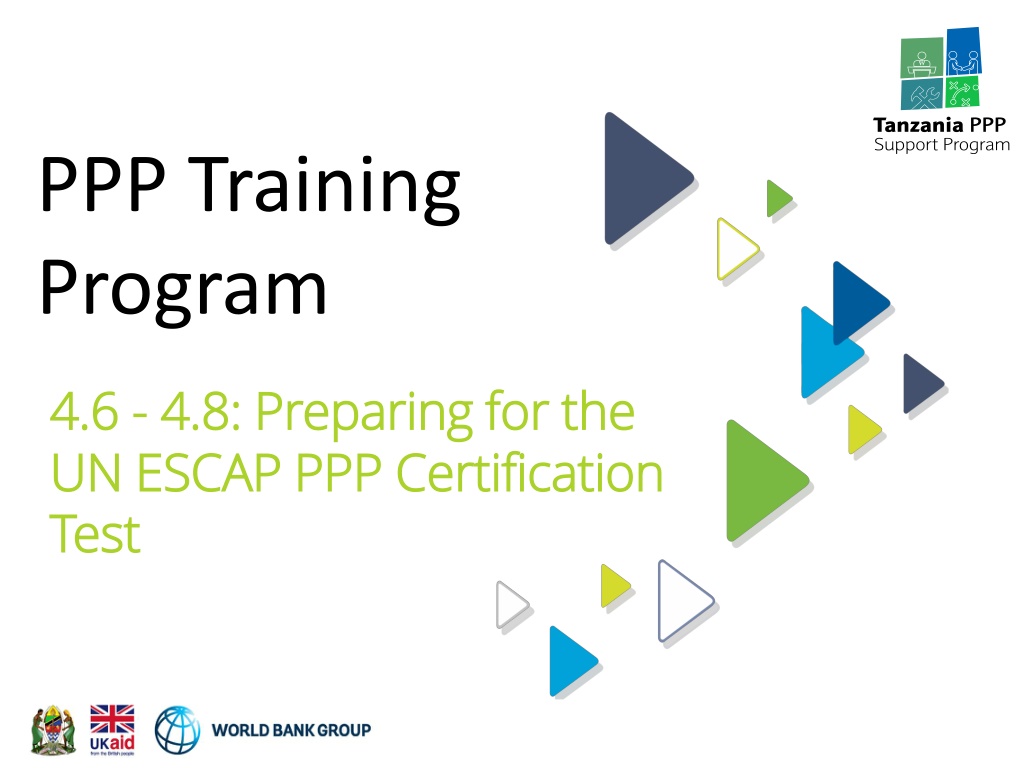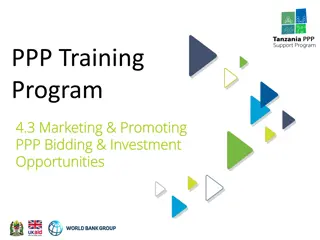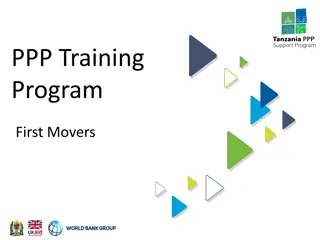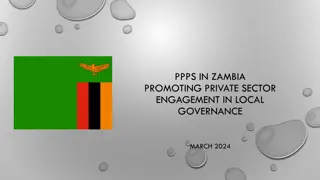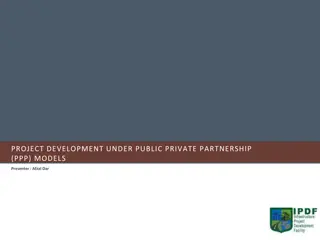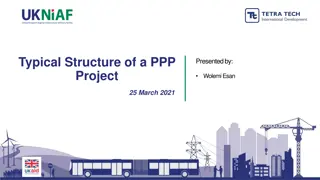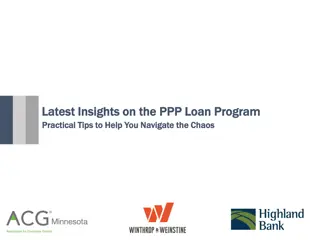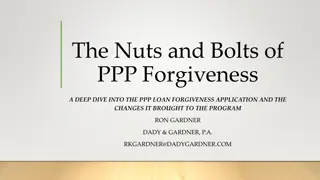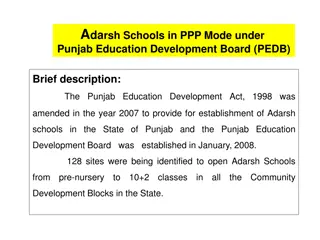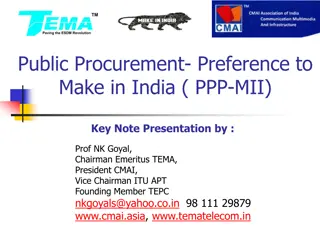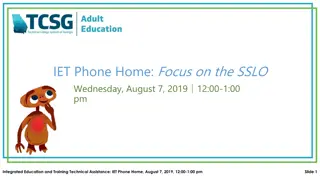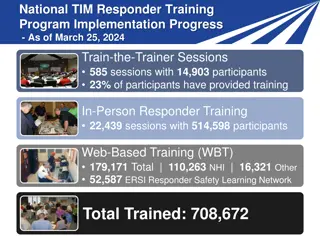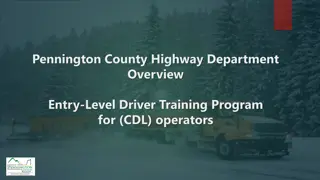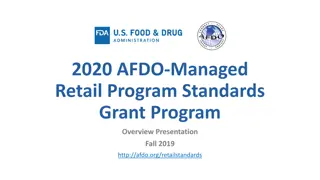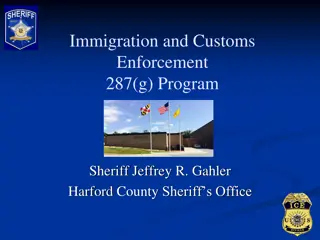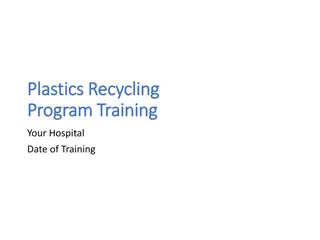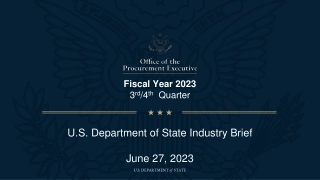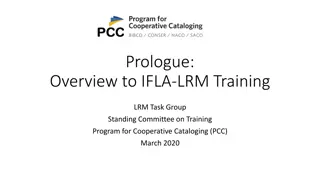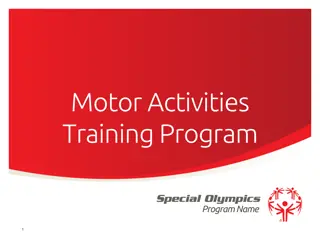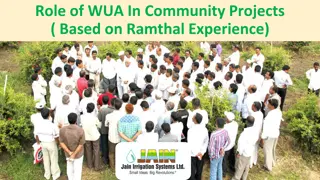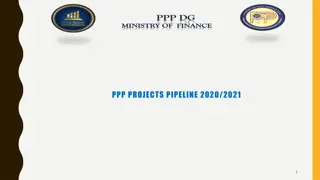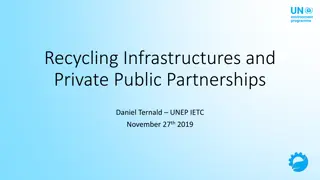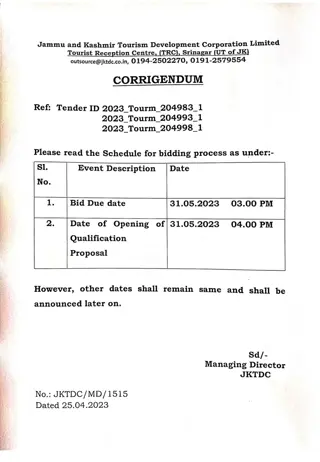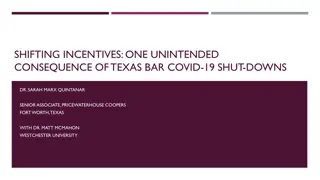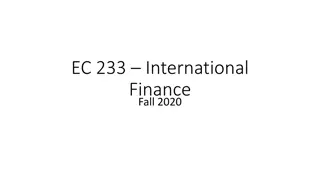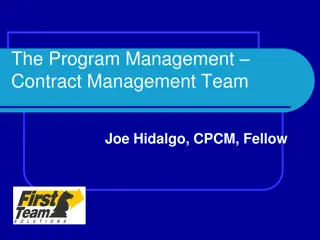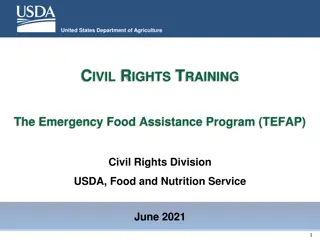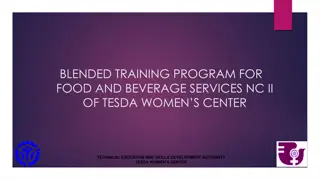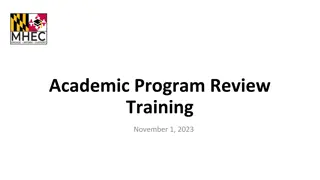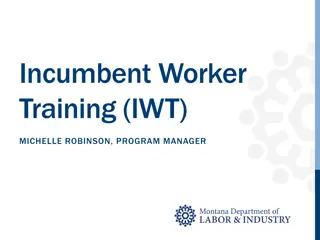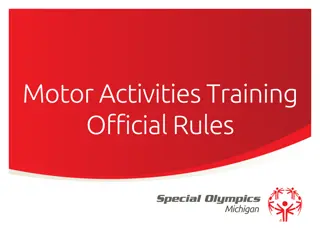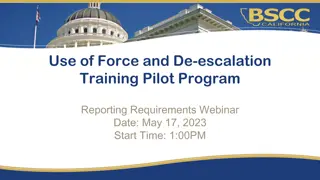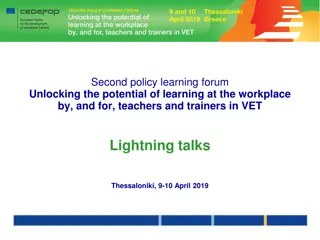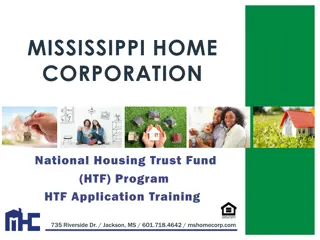UNESCAP PPP Training Program Overview
United Nations Economic & Social Commission for Asia & Pacific (UNESCAP) offers a comprehensive online PPP training program. The program covers various modules on PPP concepts, models, risk identification, project cycle, structure, financing, and case studies. Participants can obtain a PPP certification by completing the training and passing a certificate test. Register at UNESCAP to access the online video modules and enhance your knowledge on public-private partnerships.
Download Presentation

Please find below an Image/Link to download the presentation.
The content on the website is provided AS IS for your information and personal use only. It may not be sold, licensed, or shared on other websites without obtaining consent from the author. Download presentation by click this link. If you encounter any issues during the download, it is possible that the publisher has removed the file from their server.
E N D
Presentation Transcript
PPP Training Program 4.6 4.6 - - 4.8: Preparing for the 4.8: Preparing for the UN ESCAP PPP Certification UN ESCAP PPP Certification Test Test
United Nations Economic & Social United Nations Economic & Social Commission for Asia & Pacific (UNESCAP) Commission for Asia & Pacific (UNESCAP) PPP online training materials have been developed over the years by the ESCAP Secretariat. These materials are for self-study and are tailored to provide a basic minimum knowledge of various issues that policy-makers dealing with PPPs have to be aware of. While the courses are general in nature, most of the examples are from the infrastructure sectors, in particular the transport sector. The course is divided into several modules addressing the major issues related to PPPs. Module 1: PPP Concept, Benefits and Limitations Module 2: PPPs Models Module 3: Creating a PPP Enabling Environment Module 4: Risk Identification & Allocation Module 5: PPP Project Cycle Module 6: PPP Structure and Financing 2 2
http://www.unescap.org/our-work/transport/financing-and-private-sector-http://www.unescap.org/our-work/transport/financing-and-private-sector- participation/public-private-partnership-course 3 3
Step 1: Register at UNESCAPs Obtain our PPP Certification Step 1: Register at UNESCAP s Obtain our PPP Certification Web link: Web link: http://escap.ppp-e-learning-series-awareness- certificate.sgizmo.com/s3/ 4 4
UNESCAPs PPP Online Video Modules UNESCAP s PPP Online Video Modules: Module 1: PPP Concept, Benefits and Limitations Module 2: PPPs Models Module 3: Creating a PPP Enabling Environment Module 4: Risk Identification & Allocation Module 5: PPP Project Cycle Module 6: PPP Structure and Financing UNESCAP PPP Case Studies: Case 1: Traffic Demand Risk / The case of Bangkok s Skytrain (BTS) Case 2: Efficiency Gains / The case of Water Services in Manila Case 3: Mobilizing Private Funding / The case of National Highways of India Case 4: Land Value Capture Mechanism / The case of Hong Kong Mass Transit Case 5: Regulation in PPP projects / The case of Port Klang Case 6: Automatic Fare Collection System (AFCS): The Case of Manila UNESCAP PPP Certificate Test: 40 Questions (Multiple Choice & True/False) 5
UN ESCAPs 10 UN ESCAP s 10- -Minute PPP Videos Minute PPP Videos (1 per Module) (1 per Module) 6
Review Quiz Review Quiz The PPP Project Cycle: The PPP Project Cycle: 1. A good PPP for the Public is one that makes the Private Party a. assume all project risks b. Pay the highest rate of revenue-sharing with the public sector c. solve stakeholder management issues d. assume risks that it is best positioned to handle 2. All of the following are true for PPPs EXCEPT: a. They should be affordable for the users b. They should be affordable for the public contracting authority c. They should provide the lowest construction cost d. They should provide value for money 3. Which IS NOT an example of an end-user fee for a concession contract for a Bus Terminal PPP? a. Entry fees charged to each dala-dala that enters the facility b. Rents paid by shop-owners at the terminal building c. Advertising fees d. Availability payments by the LGA to the private concessionaire 8
Review Quiz The PPP Project Cycle: 4. Which of these would typically be structured as an availability payment PPP? a. A bus terminal b. A marketplace c. School Facilities d. Abattoir 5. Please complete the following sentence. The purpose of identifying & selecting candidate projects for Public-Private Partnerships (PPPs) is: to determine if a feasibility study should be done. to promise that the PPP contract will be signed and the project will reach financial closure to manage stakeholders to calculate the financial viability of the candidate PPP project a. b. c. d. 6. Before conducting the PPP project identification and selection activity, a technical study of all of the project s costs, technical design options, and benefits delivered must be completed: True False 9
Review of PPP Workshop Quiz: Review of PPP Workshop Quiz: 7. Which of the following is the most important criteria for the identification and selection of a candidate project for PPP? The size of the new private investments needed b. That it is an unsolicited proposal from an interested private investor c. That it is a priority project for the public sector d. The forecasted level of revenues the private partner will share with the Government a. 8. The most difficult challenge in making PPP projects succeed in practice is: Overcoming the shortage of financing available in the private sector b. Completing the PPP Feasibility Study c. Managing PPP stakeholders d. Drafting the PPP contract a. 10
Review of PPP Workshop Quiz: Review of PPP Workshop Quiz: 9. Why are private companies financing public infrastructure through Public-Private Partnership structure? 10. What s the difference between a concession and a BOT ? 11. The reason why governments should pursue PPPs is to access new private financing (True or False) 12. Who should decide on the inputs to a PPP project (ie technology, design, construction materials, maintenance levels, etc.)? 11
Review of PPP Workshop Quiz: Review of PPP Workshop Quiz: 13.Which risk would a private operator find the most difficult to manage in a PPP for the design, financing, construction, and operation of a municipal bus terminal PPP: a. Design risk b. Market demand/traffic risk c. Construction cost risk d. Completion risk e. Availability risk 14.An effective PPP Feasibility Study should (select the best answer): a. Confirm that a technical solution is available b. Describe different PPP modalities that could be used for the project c. Include a large and sophisticated PPP financial model d. Recommend, in detail, the financial, legal, and technical business case for the PPP e. List the inputs the private partner should be required to make in the PPP project 15.The output performance standards that a PPP project should meet: a. Should be drafted as part of the feasibility study b. Should be drafted by the LGA s PPP contract manager after signing the contract c. Should be drafted by the private partner based on level of service they want to provide d. Should be drafted by the PPP technical and engineering specialist 12
Review of PPP Workshop Quiz: Review of PPP Workshop Quiz: 16. For a BOT Project that is financed on a limited-recourse project finance basis, which party borrows the funds from lenders? a. The Government, through its Ministry of Finance b. Each of the private firms that own shares in the new PPP Project Company c. The new PPP Project Company (also known as the Special Purpose Vehicle ) d. The private construction contractor 17. What is one of the main attractions of project financing of infrastructure for Governments? a. Lower interest rates b. Low leverage c. Lenders do not have to be repaid d. The Government does not need to provide a sovereign guarantee to the project s lenders 13
Review of PPP Workshop Quiz: Review of PPP Workshop Quiz: 18. Why do equity investors require a higher rate of return on their investment than do lenders? a. Because there is less equity in PPP investments than there is debt b. They do not require a higher rate of return c. Because lenders are more efficient than equity investors d. Because equity investors accept more risk than lenders do. 19. Which of the following is an example of public sector risk-sharing for a PPP project, which enhances the creditworthiness of the project for its lenders? a. The waterfall model of project cash flows b. PPP Tendering and procurement c. Public Sector Comparator analysis d. Providing a minimum occupancy guarantee for an public housing PPP 14
Review of PPP Workshop Quiz: Review of PPP Workshop Quiz: 20.What is the most important reason to conduct short-listing and pre-qualification of bidders for PPPs, instead of allowing full and open competitive bidding? To collect more money from interested bidders who purchase the RfQ document a) To increase the number of local firms that participate in the procurement b) To improve the quality of the bids that are submitted from experienced and serious PPP bidders c) To separate the evaluation of bidders experience from the evaluation of the technical and cost proposals d) 21.What is the best reason for a PPP Unit to begin a PPP tendering process by issuing a Request for Expressions of Interest (RfEoI)? To determine early-on in the procurement process is there is a sufficient level of interest among private firms in bidding on this PPP project a) To determine which private bidder is offering the lowest price b) To review the technical inputs, including technology, design, construction materials, equipment sourcing and staffing the bidder will use c) To pre-qualify to bid all of the firms that have responded to the Request for Expressions of Interest (RfEoI) d) 15
Review of PPP Workshop Quiz: Review of PPP Workshop Quiz: 22.Which of the following statements IS TRUE about the amount of time and resources required to complete a competitive tendering for a PPP project? a) PPP procurements generally take too long to complete and this should be reduced b) Rigorous due diligence during the tendering process is required by Governments and private bidders to deliver better Value for Money (VfM), which requires time and resources c) Experienced PPP transaction advisors can pay for the higher costs of PPP procurements d) Value for money benefits can be increased by directly awarding PPP contracts sooner and deciding on PPP risk-allocations afterwards 23. Which of the following IS TRUE about the management of Unsolicited Proposals for PPPs: a) PPP contracts from unsolicited proposals are more likely to be renegotiated or cancelled, as compared to PPPs awarded through competitive tendering b) A good reason for Governments to accept unsolicited proposals to avoid having to spend their own money on PPP feasibility studies c) Private proposers are generally attracted to the idea of having their project proposal cost reimbursed or being awarded bonus points during the Swiss Challenge. d) Unsolicited proposals should not be awarded for projects that are already included in the public sector s development plans. 16
Review of PPP Workshop Quiz: Review of PPP Workshop Quiz: 24. Can all public infrastructure and public services projects be delivered through PPPs? (YES/NO) 25. In PPP projects, do private partners select their own designs, construction methods, and materials in order to achieve the cheapest operating & maintenance costs over the whole-life of the project? 26. Financial Viability vs. Economic Viability: Credit enhancement and public sector risk-sharing (like Viability Gap Funding - VGF) support the PPP financial viability but they do not change its economic viability 27. Cost overruns in a PPP project are usually supported by the public partner (TRUE/FALSE) 17
Review of PPP Workshop Quiz: Review of PPP Workshop Quiz: 28.What is Currency exchange rate risk? 29.For larger PPP projects, requiring new project financing, approximately how many bidders should be qualified to submit bids? 30.What two options does a PPP Value for Money Analysis compare? 31.Which should be higher: the PPP Project s estimated IRR or the private investor s Weighted- Average-Cost-of-Capital (WACC)? 32.Typo: Arbitration vs. Arbitrage 18
Review of PPP Workshop Quiz: Review of PPP Workshop Quiz: 33. When should a PPP Contract Monitoring Unit (CMU) first be designed? a. It should be designed after the PPP project construction is completed and it begins delivering public services b. It should be designed when the PPP project has reached financial closure and construction has begun c. An outline of the design of the CMU and its basic functions should be included in the PPP feasibility study d. It should be designed after the PPP contract between the Municipality and the private partner has been signed 34. How should the costs of a PPP Contract Monitoring Unit (CMU) be paid for? a. They should be added to the costs of the Government s General Budget b. They should be covered through the new concession fee payments from the private partner to the Government c. They should be deducted from the availability payments made to the private partner d. They should be added to the operating costs of the private partner 19
Review of PPP Workshop Quiz: Review of PPP Workshop Quiz: 36. Which of the following IS a recommended function of a PPP CMU? a. Manage and coordinate the completion of the PPP Feasibility Study. b. Provide the technical design for the new project facility. c. Audit and verify the performance reporting data from the private partner. d. Evaluate the proposals submitted by private bidders and select the winning bidder. 37. Which is the correct sequence of PPP contract dispute resolution techniques? a. Litigation, communication, termination, arbitration b. Communication, mediation, arbitration, litigation c. Mediation, arbitration, consultation, litigation d. Arbitration, mediation, litigation, termination 20
Review of PPP Workshop Quiz: Review of PPP Workshop Quiz: Governments MONITOR PPP performance, they do NOT pay all the INPUT costs Litigation in Courts is NOT the only way to resolve PPP contract disputes Low Traffic for a PPP project does Not Always impact the private partner. Often Governments will provide/support minimum traffic guarantees (Off-take agreements, etc.) During tendering a Minimum Level of interaction between Public Authority and Private Bidders is needed to ensure transparency and fairness (ie all interactions should be public, in writing, and limited to the detailed bid documents no Ex Parte Communications, etc.) Higher borrowing and Financial Leverage DOES produce cheaper total costs of financing OPM. Refinancing a project AFTER construction is completed is lower risk and therefore cheaper, ie lower interest rates. The Project s IRR should be Above the Investor s Weighted-Average Cost of Capital ( WACC ) to offer a Positive NPV 21
